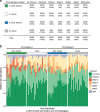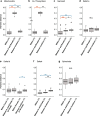Fidelity varies in the symbiosis between a gutless marine worm and its microbial consortium
- PMID: 36273146
- PMCID: PMC9587655
- DOI: 10.1186/s40168-022-01372-2
Fidelity varies in the symbiosis between a gutless marine worm and its microbial consortium
Abstract
Background: Many animals live in intimate associations with a species-rich microbiome. A key factor in maintaining these beneficial associations is fidelity, defined as the stability of associations between hosts and their microbiota over multiple host generations. Fidelity has been well studied in terrestrial hosts, particularly insects, over longer macroevolutionary time. In contrast, little is known about fidelity in marine animals with species-rich microbiomes at short microevolutionary time scales, that is at the level of a single host population. Given that natural selection acts most directly on local populations, studies of microevolutionary partner fidelity are important for revealing the ecological and evolutionary processes that drive intimate beneficial associations within animal species.
Results: In this study on the obligate symbiosis between the gutless marine annelid Olavius algarvensis and its consortium of seven co-occurring bacterial symbionts, we show that partner fidelity varies across symbiont species from strict to absent over short microevolutionary time. Using a low-coverage sequencing approach that has not yet been applied to microbial community analyses, we analysed the metagenomes of 80 O. algarvensis individuals from the Mediterranean and compared host mitochondrial and symbiont phylogenies based on single-nucleotide polymorphisms across genomes. Fidelity was highest for the two chemoautotrophic, sulphur-oxidizing symbionts that dominated the microbial consortium of all O. algarvensis individuals. In contrast, fidelity was only intermediate to absent in the sulphate-reducing and spirochaetal symbionts with lower abundance. These differences in fidelity are likely driven by both selective and stochastic forces acting on the consistency with which symbionts are vertically transmitted.
Conclusions: We hypothesize that variable degrees of fidelity are advantageous for O. algarvensis by allowing the faithful transmission of their nutritionally most important symbionts and flexibility in the acquisition of other symbionts that promote ecological plasticity in the acquisition of environmental resources. Video Abstract.
Keywords: Animal-bacterial symbiosis; Intraspecific genetic variation; Microbiome; Phylosymbiosis; Symbiont transmission.
© 2022. The Author(s).
Conflict of interest statement
The authors declare that they have no competing interests.
Figures




References
-
- Dubilier N, Bergin C, Lott C. Symbiotic diversity in marine animals: the art of harnessing chemosynthesis. Nat Rev Microbiol. 2008;6:725–740. - PubMed
-
- Ebert D. The epidemiology and evolution of symbionts with mixed-mode transmission. Annu Rev Ecol Evol Syst. 2013;44:623–643.
Publication types
MeSH terms
Substances
LinkOut - more resources
Full Text Sources

